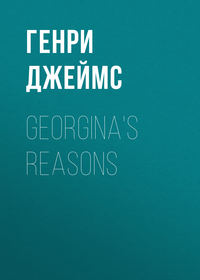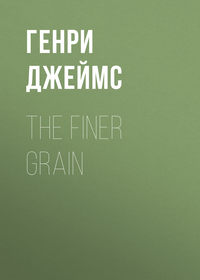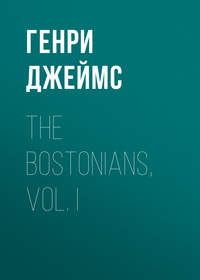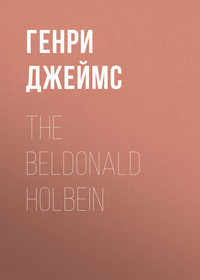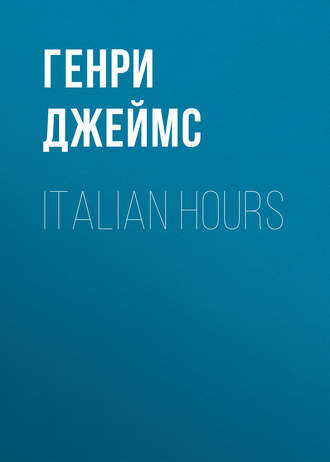 полная версия
полная версияItalian Hours
The same church contains another great picture for which the haunter of these places must find a shrine apart in his memory; one of the most interesting things he will have seen, if not the most brilliant. Nothing appeals more to him than three figures of Venetian ladies which occupy the foreground of a smallish canvas of Sebastian del Piombo, placed above the high altar of San Giovanni Crisostomo. Sebastian was a Venetian by birth, but few of his productions are to be seen in his native place; few indeed are to be seen anywhere. The picture represents the patron-saint of the church, accompanied by other saints and by the worldly votaries I have mentioned. These ladies stand together on the left, holding in their hands little white caskets; two of them are in profile, but the foremost turns her face to the spectator. This face and figure are almost unique among the beautiful things of Venice, and they leave the susceptible observer with the impression of having made, or rather having missed, a strange, a dangerous, but a most valuable, acquaintance. The lady, who is superbly handsome, is the typical Venetian of the sixteenth century, and she remains for the mind the perfect flower of that society. Never was there a greater air of breeding, a deeper expression of tranquil superiority. She walks a goddess—as if she trod without sinking the waves of the Adriatic. It is impossible to conceive a more perfect expression of the aristocratic spirit either in its pride or in its benignity. This magnificent creature is so strong and secure that she is gentle, and so quiet that in comparison all minor assumptions of calmness suggest only a vulgar alarm. But for all this there are depths of possible disorder in her light-coloured eye.
I had meant however to say nothing about her, for it’s not right to speak of Sebastian when one hasn’t found room for Carpaccio. These visions come to one, and one can neither hold them nor brush them aside. Memories of Carpaccio, the magnificent, the delightful—it’s not for want of such visitations, but only for want of space, that I haven’t said of him what I would. There is little enough need of it for Carpaccio’s sake, his fame being brighter to-day—thanks to the generous lamp Mr. Ruskin has held up to it—than it has ever been. Yet there is something ridiculous in talking of Venice without making him almost the refrain. He and the Tintoret are the two great realists, and it is hard to say which is the more human, the more various. The Tintoret had the mightier temperament, but Carpaccio, who had the advantage of more newness and more responsibility, sailed nearer to perfection. Here and there he quite touches it, as in the enchanting picture, at the Academy, of St. Ursula asleep in her little white bed, in her high clean room, where the angel visits her at dawn; or in the noble St. Jerome in his study at S. Giorgio Schiavoni. This latter work is a pearl of sentiment, and I may add without being fantastic a ruby of colour. It unites the most masterly finish with a kind of universal largeness of feeling, and he who has it well in his memory will never hear the name of Carpaccio without a throb of almost personal affection. Such indeed is the feeling that descends upon you in that wonderful little chapel of St. George of the Slaves, where this most personal and sociable of artists has expressed all the sweetness of his imagination. The place is small and incommodious, the pictures are out of sight and ill-lighted, the custodian is rapacious, the visitors are mutually intolerable, but the shabby little chapel is a palace of art. Mr. Ruskin has written a pamphlet about it which is a real aid to enjoyment, though I can’t but think the generous artist, with his keen senses and his just feeling, would have suffered to hear his eulogist declare that one of his other productions—in the Museo Civico of Palazzo Correr, a delightful portrait of two Venetian ladies with pet animals—is the “finest picture in the world.” It has no need of that to be thought admirable; and what more can a painter desire?
VIIIMay in Venice is better than April, but June is best of all. Then the days are hot, but not too hot, and the nights are more beautiful than the days. Then Venice is rosier than ever in the morning and more golden than ever as the day descends. She seems to expand and evaporate, to multiply all her reflections and iridescences. Then the life of her people and the strangeness of her constitution become a perpetual comedy, or at least a perpetual drama. Then the gondola is your sole habitation, and you spend days between sea and sky. You go to the Lido, though the Lido has been spoiled. When I first saw it, in 1869, it was a very natural place, and there was but a rough lane across the little island from the landing-place to the beach. There was a bathing-place in those days, and a restaurant, which was very bad, but where in the warm evenings your dinner didn’t much matter as you sat letting it cool on the wooden terrace that stretched out into the sea. To-day the Lido is a part of united Italy and has been made the victim of villainous improvements. A little cockney village has sprung up on its rural bosom and a third-rate boulevard leads from Santa Elisabetta to the Adriatic. There are bitumen walks and gas-lamps, lodging-houses, shops and a teatro diurno. The bathing-establishment is bigger than before, and the restaurant as well; but it is a compensation perhaps that the cuisine is no better. Such as it is, however, you won’t scorn occasionally to partake of it on the breezy platform under which bathers dart and splash, and which looks out to where the fishing-boats, with sails of orange and crimson, wander along the darkening horizon. The beach at the Lido is still lonely and beautiful, and you can easily walk away from the cockney village. The return to Venice in the sunset is classical and indispensable, and those who at that glowing hour have floated toward the towers that rise out of the lagoon will not easily part with the impression. But you indulge in larger excursions—you go to Burano and Torcello, to Malamocco and Chioggia. Torcello, like the Lido, has been improved; the deeply interesting little cathedral of the eighth century, which stood there on the edge of the sea, as touching in its ruin, with its grassy threshold and its primitive mosaics, as the bleached bones of a human skeleton washed ashore by the tide, has now been restored and made cheerful, and the charm of the place, its strange and suggestive desolation, has well-nigh departed.
It will still serve you as a pretext, however, for a day on the lagoon, especially as you will disembark at Burano and admire the wonderful fisher-folk, whose good looks—and bad manners, I am sorry to say—can scarcely be exaggerated. Burano is celebrated for the beauty of its women and the rapacity of its children, and it is a fact that though some of the ladies are rather bold about it every one of them shows you a handsome face. The children assail you for coppers, and in their desire to be satisfied pursue your gondola into the sea. Chioggia is a larger Burano, and you carry away from either place a half-sad, half-cynical, but altogether pictorial impression; the impression of bright-coloured hovels, of bathing in stagnant canals, of young girls with faces of a delicate shape and a susceptible expression, with splendid heads of hair and complexions smeared with powder, faded yellow shawls that hang like old Greek draperies, and little wooden shoes that click as they go up and down the steps of the convex bridges; of brown-cheeked matrons with lustrous tresses and high tempers, massive throats encased with gold beads, and eyes that meet your own with a certain traditional defiance. The men throughout the islands of Venice are almost as handsome as the women; I have never seen so many good-looking rascals. At Burano and Chioggia they sit mending their nets, or lounge at the street corners, where conversation is always high-pitched, or clamour to you to take a boat; and everywhere they decorate the scene with their splendid colour—cheeks and throats as richly brown as the sails of their fishing-smacks—their sea-faded tatters which are always a “costume,” their soft Venetian jargon, and the gallantry with which they wear their hats, an article that nowhere sits so well as on a mass of dense Venetian curls. If you are happy you will find yourself, after a June day in Venice (about ten o’clock), on a balcony that overhangs the Grand Canal, with your elbows on the broad ledge, a cigarette in your teeth and a little good company beside you. The gondolas pass beneath, the watery surface gleams here and there from their lamps, some of which are coloured lanterns that move mysteriously in the darkness. There are some evenings in June when there are too many gondolas, too many lanterns, too many serenades in front of the hotels. The serenading in particular is overdone; but on such a balcony as I speak of you needn’t suffer from it, for in the apartment behind you—an accessible refuge—there is more good company, there are more cigarettes. If you are wise you will step back there presently.
1882THE GRAND CANAL
The honour of representing the plan and the place at their best might perhaps appear, in the City of St. Mark, properly to belong to the splendid square which bears the patron’s name and which is the centre of Venetian life so far (this is pretty well all the way indeed) as Venetian life is a matter of strolling and chaffering, of gossiping and gaping, of circulating without a purpose, and of staring—too often with a foolish one—through the shop-windows of dealers whose hospitality makes their doorsteps dramatic, at the very vulgarest rubbish in all the modern market. If the Grand Canal, however, is not quite technically a “street,” the perverted Piazza is perhaps even less normal; and I hasten to add that I am glad not to find myself studying my subject under the international arcades, or yet (I will go the length of saying) in the solemn presence of the church. For indeed in that case I foresee I should become still more confoundingly conscious of the stumbling-block that inevitably, even with his first few words, crops up in the path of the lover of Venice who rashly addresses himself to expression. “Venetian life” is a mere literary convention, though it be an indispensable figure. The words have played an effective part in the literature of sensibility; they constituted thirty years ago the title of Mr. Howells’s delightful volume of impressions; but in using them to-day one owes some frank amends to one’s own lucidity. Let me carefully premise therefore that so often as they shall again drop from my pen, so often shall I beg to be regarded as systematically superficial.
Venetian life, in the large old sense, has long since come to an end, and the essential present character of the most melancholy of cities resides simply in its being the most beautiful of tombs. Nowhere else has the past been laid to rest with such tenderness, such a sadness of resignation and remembrance. Nowhere else is the present so alien, so discontinuous, so like a crowd in a cemetery without garlands for the graves. It has no flowers in its hands, but, as a compensation perhaps—and the thing is doubtless more to the point—it has money and little red books. The everlasting shuffle of these irresponsible visitors in the Piazza is contemporary Venetian life. Everything else is only a reverberation of that. The vast mausoleum has a turnstile at the door, and a functionary in a shabby uniform lets you in, as per tariff, to see how dead it is. From this constatation, this cold curiosity, proceed all the industry, the prosperity, the vitality of the place. The shopkeepers and gondoliers, the beggars and the models, depend upon it for a living; they are the custodians and the ushers of the great museum—they are even themselves to a certain extent the objects of exhibition. It is in the wide vestibule of the square that the polygot pilgrims gather most densely; Piazza San Marco is the lobby of the opera in the intervals of the performance. The present fortune of Venice, the lamentable difference, is most easily measured there, and that is why, in the effort to resist our pessimism, we must turn away both from the purchasers and from the vendors of ricordi. The ricordi that we prefer are gathered best where the gondola glides—best of all on the noble waterway that begins in its glory at the Salute and ends in its abasement at the railway station. It is, however, the cockneyfied Piazzetta (forgive me, shade of St. Theodore—has not a brand new café begun to glare there, electrically, this very year?) that introduces us most directly to the great picture by which the Grand Canal works its first spell, and to which a thousand artists, not always with a talent apiece, have paid their tribute. We pass into the Piazzetta to look down the great throat, as it were, of Venice, and the vision must console us for turning our back on St. Mark’s.
We have been treated to it again and again, of course, even if we have never stirred from home; but that is only a reason the more for catching at any freshness that may be left in the world of photography. It is in Venice above all that we hear the small buzz of this vulgarising voice of the familiar; yet perhaps it is in Venice too that the picturesque fact has best mastered the pious secret of how to wait for us. Even the classic Salute waits like some great lady on the threshold of her saloon. She is more ample and serene, more seated at her door, than all the copyists have told us, with her domes and scrolls, her scolloped buttresses and statues forming a pompous crown, and her wide steps disposed on the ground like the train of a robe. This fine air of the woman of the world is carried out by the well-bred assurance with which she looks in the direction of her old-fashioned Byzantine neighbour; and the juxtaposition of two churches so distinguished and so different, each splendid in its sort, is a sufficient mark of the scale and range of Venice. However, we ourselves are looking away from St. Mark’s—we must blind our eyes to that dazzle; without it indeed there are brightnesses and fascinations enough. We see them in abundance even while we look away from the shady steps of the Salute. These steps are cool in the morning, yet I don’t know that I can justify my excessive fondness for them any better than I can explain a hundred of the other vague infatuations with which Venice sophisticates the spirit. Under such an influence fortunately one need n’t explain—it keeps account of nothing but perceptions and affections. It is from the Salute steps perhaps, of a summer morning, that this view of the open mouth of the city is most brilliantly amusing. The whole thing composes as if composition were the chief end of human institutions. The charming architectural promontory of the Dogana stretches out the most graceful of arms, balancing in its hand the gilded globe on which revolves the delightful satirical figure of a little weathercock of a woman. This Fortune, this Navigation, or whatever she is called—she surely needs no name—catches the wind in the bit of drapery of which she has divested her rotary bronze loveliness. On the other side of the Canal twinkles and glitters the long row of the happy palaces which are mainly expensive hotels. There is a little of everything everywhere, in the bright Venetian air, but to these houses belongs especially the appearance of sitting, across the water, at the receipt of custom, of watching in their hypocritical loveliness for the stranger and the victim. I call them happy, because even their sordid uses and their vulgar signs melt somehow, with their vague sea-stained pinks and drabs, into that strange gaiety of light and colour which is made up of the reflection of superannuated things. The atmosphere plays over them like a laugh, they are of the essence of the sad old joke. They are almost as charming from other places as they are from their own balconies, and share fully in that universal privilege of Venetian objects which consists of being both the picture and the point of view.
This double character, which is particularly strong in the Grand Canal, adds a difficulty to any control of one’s notes. The Grand Canal may be practically, as in impression, the cushioned balcony of a high and well-loved palace—the memory of irresistible evenings, of the sociable elbow, of endless lingering and looking; or it may evoke the restlessness of a fresh curiosity, of methodical inquiry, in a gondola piled with references. There are no references, I ought to mention, in the present remarks, which sacrifice to accident, not to completeness. A rhapsody of Venice is always in order, but I think the catalogues are finished. I should not attempt to write here the names of all the palaces, even if the number of those I find myself able to remember in the immense array were less insignificant. There are many I delight in that I don’t know, or at least don’t keep, apart. Then there are the bad reasons for preference that are better than the good, and all the sweet bribery of association and recollection. These things, as one stands on the Salute steps, are so many delicate fingers to pick straight out of the row a dear little featureless house which, with its pale green shutters, looks straight across at the great door and through the very keyhole, as it were, of the church, and which I needn’t call by a name—a pleasant American name—that every one in Venice, these many years, has had on grateful lips. It is the very friendliest house in all the wide world, and it has, as it deserves to have, the most beautiful position. It is a real porto di mare, as the gondoliers say—a port within a port; it sees everything that comes and goes, and takes it all in with practised eyes. Not a tint or a hint of the immense iridescence is lost upon it, and there are days of exquisite colour on which it may fancy itself the heart of the wonderful prism. We wave to it from the Salute steps, which we must decidedly leave if we wish to get on, a grateful hand across the water, and turn into the big white church of Longhena—an empty shaft beneath a perfunctory dome—where an American family and a German party, huddled in a corner upon a pair of benches, are gazing, with a conscientiousness worthy of a better cause, at nothing in particular.
For there is nothing particular in this cold and conventional temple to gaze at save the great Tintoretto of the sacristy, to which we quickly pay our respects, and which we are glad to have for ten minutes to ourselves. The picture, though full of beauty, is not the finest of the master’s; but it serves again as well as another to transport—there is no other word—those of his lovers for whom, in far-away days when Venice was an early rapture, this strange and mystifying painter was almost the supreme revelation. The plastic arts may have less to say to us than in the hungry years of youth, and the celebrated picture in general be more of a blank; but more than the others any fine Tintoret still carries us back, calling up not only the rich particular vision but the freshness of the old wonder. Many things come and go, but this great artist remains for us in Venice a part of the company of the mind. The others are there in their obvious glory, but he is the only one for whom the imagination, in our expressive modern phrase, sits up. “The Marriage in Cana,” at the Salute, has all his characteristic and fascinating unexpectedness—the sacrifice of the figure of our Lord, who is reduced to the mere final point of a clever perspective, and the free, joyous presentation of all the other elements of the feast. Why, in spite of this queer one-sidedness, does the picture give us no impression of a lack of what the critics call reverence? For no other reason that I can think of than because it happens to be the work of its author, in whose very mistakes there is a singular wisdom. Mr. Ruskin has spoken with sufficient eloquence of the serious loveliness of the row of heads of the women on the right, who talk to each other as they sit at the foreshortened banquet. There could be no better example of the roving independence of the painter’s vision, a real spirit of adventure for which his subject was always a cluster of accidents; not an obvious order, but a sort of peopled and agitated chapter of life, in which the figures are submissive pictorial notes. These notes are all there in their beauty and heterogeneity, and if the abundance is of a kind to make the principle of selection seem in comparison timid, yet the sense of “composition” in the spectator—if it happen to exist—reaches out to the painter in peculiar sympathy. Dull must be the spirit of the worker tormented in any field of art with that particular question who is not moved to recognise in the eternal problem the high fellowship of Tintoretto.
If the long reach from this point to the deplorable iron bridge which discharges the pedestrian at the Academy—or, more comprehensively, to the painted and gilded Gothic of the noble Palazzo Foscari—is too much of a curve to be seen at any one point as a whole, it represents the better the arched neck, as it were, of the undulating serpent of which the Canalazzo has the likeness. We pass a dozen historic houses, we note in our passage a hundred component “bits,” with the baffled sketcher’s sense, and with what would doubtless be, save for our intensely Venetian fatalism, the baffled sketcher’s temper. It is the early palaces, of course, and also, to be fair, some of the late, if we could take them one by one, that give the Canal the best of its grand air. The fairest are often cheek-by-jowl with the foulest, and there are few, alas, so fair as to have been completely protected by their beauty. The ages and the generations have worked their will on them, and the wind and the weather have had much to say; but disfigured and dishonoured as they are, with the bruises of their marbles and the patience of their ruin, there is nothing like them in the world, and the long succession of their faded, conscious faces makes of the quiet waterway they overhang a promenade historique of which the lesson, however often we read it, gives, in the depth of its interest, an incomparable dignity to Venice. We read it in the Romanesque arches, crooked to-day in their very curves, of the early middle-age, in the exquisite individual Gothic of the splendid time, and in the cornices and columns of a decadence almost as proud. These things at present are almost equally touching in their good faith; they have each in their degree so effectually parted with their pride. They have lived on as they could and lasted as they might, and we hold them to no account of their infirmities, for even those of them whose blank eyes to-day meet criticism with most submission are far less vulgar than the uses we have mainly managed to put them to. We have botched them and patched them and covered them with sordid signs; we have restored and improved them with a merciless taste, and the best of them we have made over to the pedlars. Some of the most striking objects in the finest vistas at present are the huge advertisements of the curiosity-shops.
The antiquity-mongers in Venice have all the courage of their opinion, and it is easy to see how well they know they can confound you with an unanswerable question. What is the whole place but a curiosity-shop, and what are you here for yourself but to pick up odds and ends? “We pick them up for you,” say these honest Jews, whose prices are marked in dollars, “and who shall blame us if, the flowers being pretty well plucked, we add an artificial rose or two to the composition of the bouquet?” They take care, in a word, that there be plenty of relics, and their establishments are huge and active. They administer the antidote to pedantry, and you can complain of them only if you never cross their thresholds. If you take this step you are lost, for you have parted with the correctness of your attitude. Venice becomes frankly from such a moment the big depressing dazzling joke in which after all our sense of her contradictions sinks to rest—the grimace of an over-strained philosophy. It’s rather a comfort, for the curiosity-shops are amusing. You have bad moments indeed as you stand in their halls of humbug and, in the intervals of haggling, hear through the high windows the soft splash of the sea on the old water-steps, for you think with anger of the noble homes that are laid waste in such scenes, of the delicate lives that must have been, that might still be, led there. You reconstruct the admirable house according to your own needs; leaning on a back balcony, you drop your eyes into one of the little green gardens with which, for the most part, such establishments are exasperatingly blessed, and end by feeling it a shame that you yourself are not in possession. (I take for granted, of course, that as you go and come you are, in imagination, perpetually lodging yourself and setting up your gods; for if this innocent pastime, this borrowing of the mind, be not your favourite sport there is a flaw in the appeal that Venice makes to you.) There may be happy cases in which your envy is tempered, or perhaps I should rather say intensified, by real participation. If you have had the good fortune to enjoy the hospitality of an old Venetian home and to lead your life a little in the painted chambers that still echo with one of the historic names, you have entered by the shortest step into the inner spirit of the place. If it did n’t savour of treachery to private kindness I should like to speak frankly of one of these delightful, even though alienated, structures, to refer to it as a splendid example of the old palatial type. But I can only do so in passing, with a hundred precautions, and, lifting the curtain at the edge, drop a commemorative word on the success with which, in this particularly happy instance, the cosmopolite habit, the modern sympathy, the intelligent, flexible attitude, the latest fruit of time, adjust themselves to the great gilded, relinquished shell and try to fill it out. A Venetian palace that has not too grossly suffered and that is not overwhelming by its mass makes almost any life graceful that may be led in it. With cultivated and generous contemporary ways it reveals a pre-established harmony. As you live in it day after day its beauty and its interest sink more deeply into your spirit; it has its moods and its hours and its mystic voices and its shifting expressions. If in the absence of its masters you have happened to have it to yourself for twenty-four hours you will never forget the charm of its haunted stillness, late on the summer afternoon for instance, when the call of playing children comes in behind from the campo, nor the way the old ghosts seemed to pass on tip-toe on the marble floors. It gives you practically the essence of the matter that we are considering, for beneath the high balconies Venice comes and goes, and the particular stretch you command contains all the characteristics. Everything has its turn, from the heavy barges of merchandise, pushed by long poles and the patient shoulder, to the floating pavilions of the great serenades, and you may study at your leisure the admirable Venetian arts of managing a boat and organising a spectacle. Of the beautiful free stroke with which the gondola, especially when there are two oars, is impelled, you never, in the Venetian scene, grow weary; it is always in the picture, and the large profiled action that lets the standing rowers throw themselves forward to a constant recovery has the double value of being, at the fag-end of greatness, the only energetic note. The people from the hotels are always afloat, and, at the hotel pace, the solitary gondolier (like the solitary horseman of the old-fashioned novel) is, I confess, a somewhat melancholy figure. Perched on his poop without a mate, he re-enacts perpetually, in high relief, with his toes turned out, the comedy of his odd and charming movement. He always has a little the look of an absent-minded nursery-maid pushing her small charges in a perambulator.



